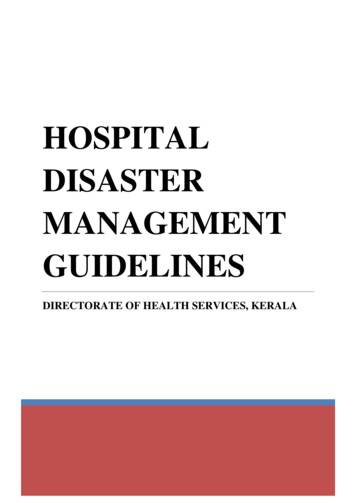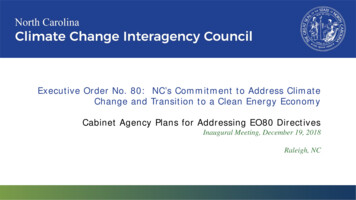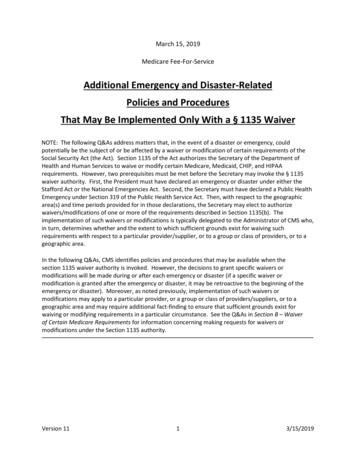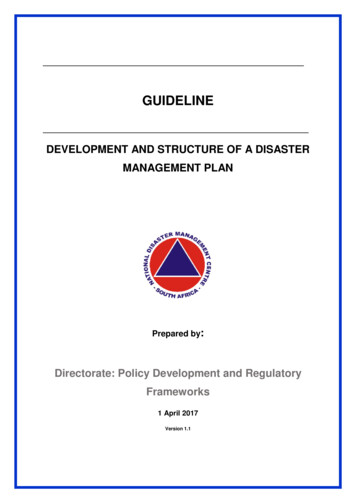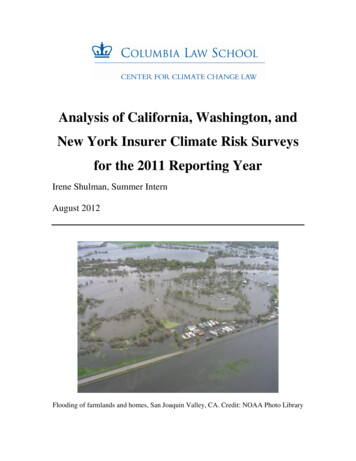
Transcription
CLIMATE CHANGE AND DISASTERMANAGEMENT IN BANGLADESHINFORMATION BRIEFPhoto: Zahid HasanKEY POINTS Bangladesh is generally a disaster pronecountry. The frequency of disaster will increase asan impact of climate change hamperingdevelopment. Thegovernmenthastakencomprehensive disaster managementprograms to battle climate change.
INTRODUCTIONBangladesh is highly susceptible to varying climatechanges. It is a country where three major riversconverge, a country largely made up of low lying floodplains and that is the statistical focus of the cyclonegenerating Bay of Bengal (BoB). The past hasdemonstrated how devastating major climatic eventscan be. Storms, such as Cyclone Gorky (1991) - whichkilled more than 130,000 people and left 10 millionpeople homeless - demonstrate the extreme severity ofthese events. Although events like these are theextreme examples, there are numerous other impactsregionally across a number of sectors. It is widelyaccepted in the scientific community that climaticevents such as these will increase globally. This paperaims to address how these climatic impacts will affectBangladesh.The Government of Bangladesh (GoB) has investedmore than 10 billion over the last 35 years to make thecountry resilient to cope with the recurrent climaticevents. Disaster management strategies have beendeveloped over times that are both practical andeffective. Any country susceptible to similar events dueto these climactic impacts can learn from these modelsand strategies.IMPACTS OF CLIMATE CHANGEDuring the 20th century the average globaltemperature has risen by 0.8 C over land and 0.5 C atsea. It is widely agreed by the scientific community thathuman activities are altering our climate system andthat the temperature is on the rise. The impactspredicted by the United Nations IntergovernmentalPanel on Climate Change (IPCC) are as follows: ingeneral, there will be an increase in frequency, intensityand magnitude of extreme weather patterns, theintrusion of freshwater reserves in coastal areas and therise of sea levels.1Many of the impacts of climate change will reinforcethe environmental, socio-economic and demographicstresses already faced by Bangladesh. Climate change islikely to result in:Increased FloodingPrecipitation extremes will result in increased flooding,both because of the increase in monsoon rains, and dueto the increased incidences of flash floods induced byerratic precipitation regimes.Coastal flooding is a major impact of sea level rise. Thisis higher in Bangladesh because of the effects oftectonic subsidence.2 Sea level rise is also associatedwith increased riverside flooding, because it eghna Rivers along the delta.3This will result in increased drainage congestion due tohigher water levels, which will be exacerbated by otherfactors associated with climate change such as siltationof estuary branches in line with increased surfacerunoff, and higher riverbed levels.4Higher temperatures will result in increased glaciermelt, increasing runoff from the neighbouringHimalayas into the Ganges and Brahmaputra rivers. Therecent Intergovernmental Panel on Climate ChangeIPCC Fourth Assessment Report (FAR) states thatglaciers in the Himalayas are receding faster than in anyother part of the world, and this can be attributedprimarily to global warming.5Increased Vulnerability to Cyclone and Storm surgesThere is evidence of a 5-10 percent increase in intensity(wind speed) that would contribute to enhanced storm1 Intergovernmental Panel on Climate Change (IPCC). (2007). Climate Change: Impacts, Adaptation and Vulnerability. IPCC Working Group II Report,Chapter 19.2 Huq, S. (2001). Climate Change and Bangladesh. Science, (294): p. 1617.3 Agrawala, S., Ota, T., Ahmed, A. U., Smith, J. and Aalst, M. V. (2003). Development and Climate Change in Bangladesh: Focus on Coastal Flooding and theSundarbans 2003. Organisation for Economic Co-operation and Development (OECD).4 Policy Department Economy and Science, DG Internal Policies, European Parliament Climate Change Impacts and Responses in Bangladesh, ittees/studies/download.do?file 191955 Cruz, R.V., Harasawa, H., Lal, M., Wu, S., Anokhin, Y., Punsalmaa, B., Honda, Y., Jafari, M., Li, C,.and Huu Ninh, N. (2007). ‘Asia’. In: M.L. Parry, O.F. Canziani, J.P.Palutikof, P.J. van der Linden and C.E. Hanson (eds.), Climate Change 2007: Impacts, Adaptation and Vulnerability, Contribution of Working Group II tothe Fourth Assessment Report of the Intergovernmental Panel on Climate Change, pp. 469-506. Cambridge University Press, Cambridge, UK.02
surges and coastal flooding, and also project a 20 percent increase in intensity of associated precipitationthat would contribute to flooding.3 Cyclonic winds arelikely to increase in intensity because of the positivecorrelation with temperature rise in sea surface. InNovember 2007, for example, the tropical cyclone SIDR,with a 100 mile long front covering the breadth of thecountry and with winds up to 240 km per hour, hitBangladesh. This was noted to be an unusualoccurrence given the intensity and timing of the storm,particularly the fact that it occurred in the same year astwo recurrent floods.6 The IPCC FAR has identified thatclimate change will be associated with greaterprecipitation extremes, which includes more intensemonsoon rainfall.1Increased DroughtsClimate change will exacerbate drought in Bangladeshboth in terms of intensity and frequency, higher meantemperatures and potentially reduced dry seasonprecipitation. Monsoon rains produce 80% ofBangladesh’s annual precipitation, and when this isreduced, drought is a significant problem; between1960 and 1991, a total of 19 droughts occurred inBangladesh.3The Southwest and Northwest regions are particularlysusceptible to drought. Greater precipitation extremesassociated with climate change also mean less rainfallin the dry season, which will increase water stress onthose areas that already experience water shortages,particularly in the winter months. This will be worse forthose areas that depend on glacial melt water for theirmain dry-season water supply, as glaciers recede withrising temperatures.Decreased Availability of Fresh WaterThe availability of freshwater will be reduced byincreased intrusion of salinity into fresh water sourcesduring the low flow conditions. In the coastal regionsthis is brought about by sea level rise resulting in salinewater intrusion in the estuaries and into thegroundwater. The effects are exacerbated by greaterevaporation of freshwater as temperatures increase,coupled with a greater demand for fresh water in timesof water stress.7Greater Temperature ExtremesClimate change is associated with warmer summersand colder winters. Temperatures in Bangladesh haveincreased about 1 C in May and 0.5 C in Novemberbetween 1985 and 1998, and further temperatureincreases are expected. However, although the overallclimate is warming, temperature extremes areincreasing, and winter temperatures as low as 5 C havebeen recorded in January 2007, reportedly the lowest in38 years.1RESULTANT IMPACTS AND ECONOMIC LOSSESThe impacts of climate change on Bangladesh havesignificant implications for its economic development,social welfare and culture. These impacts will bediscussed for different sectors, in terms of “humandimensions” of climate change.1AgricultureThe economy of Bangladesh is based on agriculture,with two thirds of the population engaged in orindirectly relying on agricultural activities. Agriculture isone of the most climate sensitive sectors,8 sincechanges in temperature, rainfall patterns, and increasedlikelihood of extreme events such as droughts andfloods, determine the crop yields. Although an increasein CO2 levels could moderately increase temperaturewhich may result in an increase in crop productionthrough carbon fertilization, modelling studies suggestthat increasing frequency of crop loss due to extremeevents, such as droughts and heavy precipitation, mayovercome any benefits of moderate temperatureincreases.96Sayeed, S.K. (2007). Climate change and Bangladesh: A perspective on where we are. The Daily Star. Dhaka.7S.M. Mahbubur Rahman, Institute for Water Modelling, Bangladesh. Water infrastructure responses to climate change. Presentation delivered at“Economic Approaches to Climate Change and Poverty: a workshop for economic policy makers and researchers in Bangladesh”, 13-14 October2009, Dhaka, Bangladesh.8Cline, W.R. (2007). Global Warming and Agriculture. Impact Estimates by Country. Washington DC: Centre for Global Development and thePeterson Institute for International Economics.9Easterling, W.E., Aggarwal, P.K. , Batima, P. , Brander, K.M., Erda, L., Howden, S.M., Kirilenko, A., Morton, J., Soussana, J.F., Schmidhuber, J. and Tubiello,F.N. (2007). ‘Food, fibre and forest products’. In: M.L. Parry, O.F. Canziani, J.P. Palutikof, P.J. van der Linden and C.E. Hanson (eds.), Climate Change2007: Impacts, Adaptation and Vulnerability, Contribution of Working Group II to the Fourth Assessment Report of the Intergovernmental Panel onClimate Change, pp. 273-313. Cambridge University Press, Cambridge, UK.03
Forestry and BiodiversityMANAGING CLIMATIC HAZARDSBangladesh has a diverse range of forest ecosystems,including bamboo, freshwater swamp forests andmangroves. The Sundarbans of Bangladesh, a worldheritage site, is the single largest mangrove area in theworld, comprising an area of 57,700 hectare andhousing one of the richest natural gene pools. A total of425 species have been identified in the Sundarbans, themost notable of which is the Royal Bengal Tiger, whichis endemic to the area.Bangladesh benefits from a long history of designingand implementing various types of adaptationactivities (both policies and capital investment)especially for floods and cyclones. Over the last threedecades, the GoB has invested over 10 billion (atconstant 2007 prices) to make the country moreclimate resilient and less vulnerable to naturaldisasters.12 Since the 1970s, the GoB with the supportof development partners has invested in:Climate change will have a detrimental impact on all ofthe forest ecosystems in Bangladesh, and theSundarbans are likely to be the worst affected.10 Thechanges in temperature and water will result in directpressure on many climate-sensitive species, and causeincreased erosion and deterioration of soil quality inupland forested areas. Flood management and irrigation schemes toIncreased rainfall intensity will cause enhanced erosionin upstream and cause sedimentation. The Sundarbansalso offer subsistence to around 3.5 million inhabitantsthat live in and around the forest boundary. Theinundation and intruding salinity is alreadyinterrupting traditional practices in the Sundarbans.HealthClimate change affects health directly and indirectly.The direct impacts of climate change on human healthoccur through extreme events, for example the floodsin Bangladesh in 2004 caused 800 deaths, while therecent cyclone Cidr, affected more than 8.5 millionpeople, causing more than 3,500 deaths.6Climate change will also affect the distribution ofclimate sensitive diseases. Malaria is a frequently citedexample, because its prevalence increases with thewarmer, wetter climates. Incidences of malaria haveincreased dramatically in Bangladesh over the last 30years, and it is now a major public health problem, with14.7 million people in Bangladesh classified as being athigh risk for catching the disease.11raise agricultural productivity in low lyingareas; Flood protection and drainage in urban areas; Coastal embankment projects to prevent tidalflooding and incursions of saline water; Multi-purpose cyclone shelters; Disaster management, response and recoveryprojects; Irrigation schemes to enable dry season crop; Agriculture research programs to developsaline, drought and flood tolerant, highyielding crop varieties; and Coastal ‘greenbelt’ (afforestation) projects.Recognizing the ‘urgent and immediate’ vulnerability ofits development objectives to climate change, GoBprepared the National Adaptation Programme ofAction (NAPA) in 2005. This was followed by thepreparation of the Bangladesh Climate ChangeStrategy and Action Plan (BCCSAP), 2009, by theMinistry of Environment and Forest in consultation withall relevant stakeholders. The BCCSAP has been themain basis for the Government’s efforts to combatclimate change over a 10-year program to build thecapacity and resilience of Bangladesh. The planenvisions a financing need of about 5 billion duringthe first 5 years through 2014.10 Rahman, A. and Alam, M. (2003). ‘Mainstreaming Adaptation to Climate Change in Least Developed Countries (LDCs): Bangladesh Country CaseStudy’. IIED Working Paper, (2).11 Reid, H. and Sims. A. (2007). Up in smoke? Asia and the Pacific. Up in Smoke Working Group on Climate Change and Development. p. 92.12 World Bank. (2009). ‘Bangladesh: Economics of Adaptation to Climate Change Study’. mics-adaptation-climate-change-study.04
POLICY AND INSTITUTIONAL FRAMEWORKcultivated land and sea product culturing area is likelyto become salt marsh.Within the South Asian region Bangladesh is wellknown for its disaster management policy andframework. Being the most disaster-prone countrywithin South Asia, Bangladesh is the first to have aseparate Disaster Management Bureau (DMB) since1993. The country has a good number of institutionalstructures to achieve technical monitoring, capacitybuilding, preparedness and response. The Ministry ofFood and Disaster Management is responsible forcoordinating national disaster management effortsacross all agencies. In 2004 MoFDM launched theComprehensive Disaster Management Programme(CDMP), (currently in its second phase), to facilitatereform of the disaster management approach byexpanding its focus from reactive emergency responseto proactive risk reduction. Projected sea-level rise could flood theThe scope of the plan includes natural and man-madedisasters including climate change with a view to identifywhen, where and in what frequency these threats are likelyto occur. Accordingly the plan takes into consideration ofimpacts projected by IPCC on Bangladesh:diarrhoea and malnutrition attributable toclimate-change are already the largest inBangladesh. Landdegradation, shortfalls in foodproduction, rural poverty and urban unrest.In order to tackle the current and future challenges,theplan formulated a disaster management model asfollows:BANGLADESH DISASTER MANAGEMENT MODELDefining and Redefining the Risk Environment Technical and traditional analysis Climate change and climate variability impacts Community risk assessment based on bestpractice model Documentation of vulnerability and risk factors All hazards; all risks; all sectors focusManaging the Risk Environment Achieving a good balance of risk reduction options Moving from generic hazard to risk specificprogrammes Sustaining service delivery through partnerships Utilizing technical and traditional analysis tostrengthen preparedness and emergency response systemsincluding early warningFeedback loopRisk ReductionThe National Plan for Disaster Management(2010-2015) has recently been approved from theNational Disaster Management Council. It has beenprepared aiming at reducing vulnerability of the poorto natural, environmental and human-induced disasterto a manageable and acceptable level. The plan hasbeen developed in line with the government missiontaking into consideration the Hyogo Framework forAction 2005-2015 and adopting the SAARC Frameworkon disaster management. Global burden (mortality and morbidity) ofEmergencyResponseA National Disaster Management Policy will beformulated to define the national perspective ondisaster risk reduction and emergency management,and to describe the strategic framework, and nationalprinciples of disaster management in Bangladesh. It willbe of strategic in nature and will describe the broadnational objectives, and strategies in disastermanagement.residence of millions of people living in thelow-lying areas such as in Bangladesh.Responding to the Threat Environment Activating systems and mobilizing resources Utilizing vulnerability and risk databases toanticipate potential impact scenarios Maintaining effective communication and reporting Documenting, learningThe key targets, actions and outcomes to be achievedby 2015under the National Plan for DisasterManagement are organized under seven strategicgoals as follows: Production of rice and wheat might drop by 8percent and 32 percent respectively by theyear 2050. Increasing salinity of the groundwater as wellas surface water resources. Sea level rise as a direct impact of globalwarming and 1,000 square kilometers of1.0 Professionalizing the disaster managementsystem: through establishing a regulatory framework,professional development and through training.2.0 Mainstreaming Disaster Risk Reduction andClimate Change adaptation: incorporation of riskreduction and climate change adaptation principles05
and practices into all development programmes andpolicies, sectoral policies and plans and in NGOprogrammes and plans.3.0 Strengthening Institutional Mechanisms:Capacity building of DMCs at all levels, institutionalizenational training capacity, including monitoring.4.0 Empowering Communities At Risk: uniform CRAguideline to identify community and household levelrisks, formulate adaptation action planning, strengthencommunity and household level capacity and bringcommunities under social safety nets.5.0 Expanding Risk Reduction Programming acrosshazards and sectors: Update hazard maps, developclimate change scenarios and associated hazard risks,establish an Integrated Approach, preparedness,hazard and risk specific capacity building program,prediction and monitoring.6.0 Strengthening Emergency Response Systems:Strengthen and improve an all hazard early warningsystems, dissemination through a National DisasterManagement Information Centre with an internetconnection with all the 64 Districts and high riskUpazila DMCs, establish Community Alerting System,establish and improve Search and Rescue Mechanism,develop and establish emergency response plans anddevelop and establish post disaster recovery andreconstruction mechanism.7.0 Developing and strengthening regional andglobal Networks: Establish public and privatepartnerships for disaster risk reduction and supportregional and global initiatives.The Standing Orders on Disaster (SOD) is anothercritical component of disaster management frameworkin the country. It describes the detailed roles andresponsibilities of committees, Ministries and otherNational Disaster Management Council(NDMC)Ministry of Food and DisasterManagement (MoFDM)Inter Ministerial Disaster ManagementCoordination Committee (IMDMCC)National Platform for DisasterRisk Reduction (NPDRR)CPP Implementation Board(CPPIB)Disaster Management andRelief Division (DM&RD)Disaster Management Bureau(DMB)National Disaster Management AdvisoryCommittee (NDMAC)Food DivisionEarthquake Preparednessand AwarenessDirectorate of Relief andRehabilitation (DRR)Director General of Food(DG Food)District Disaster ManagementCommittee (DDMC)City Corporation DisasterManagement Committee(CCDMC)Municipal Disaster ManagementCommittee (MDMC)Zone /UpazilaUpazila Disaster ManagementCommittee (UzDMC)CSDDWSUnion Disaster ManagementCommittee (UDMC)UnionFPOCGNGOCCDMTATFFigure 1: Disaster management Institutions in Bangladesh06
organizations in disaster risk reduction and emergencymanagement, and establishes the necessary actionsrequired in implementing Bangladesh’s DisasterManagement Model. The Standing Orders have beenprepared with the objective of making the concernedpersons understand their duties and responsibilitiesregarding disaster management at all levels, tments and Agencies shall preparetheir own Action Plans in respect of theirresponsibilities under the Standing Orders for efficientimplementation. The National Disaster ManagementCouncil (NDMC) and Inter-Ministerial DisasterManagement Coordination Committee (IMDMCC) willensure coordination of disaster related activities at theNational level. Coordination at District, Thana andUnion levels will be done by the respective District,Thana and Union Disaster Management Committees.The Disaster Management Bureau will render allassistance to them by facilitating the process. Theinstitutions involved in disaster management inBangladesh are shown in figure 1.In addition to SOD, guidelines for Government at alllevels are developed as best practice models, and areused to assist Ministries, NGOs, disaster managementcommittees and civil society in implementing disasterrisk management. Guidelines will include, amongothers, - Disaster Impact and Risk Assessment Guideline,Local Disaster Risk Reduction Fund ManagementGuidelines, Community Risk Assessment Guidelines etc.The regulatory framework is shown in Figure 2.FINANCING DISASTERThe Government has decided to constitute a fundcalled the “National Disaster Response and RecoveryFund” from its own resources and donations from homeand abroad. The fund shall be used for response, reliefand recovery. The Government will constitute anotherfund called the “National Risk Reduction Fund” forprojects which are designed for the purpose ofprevention, mitigation and preparedness. RelevantMinistries/ Divisions/ Directorates and departmentswill make provisions in its annual budget to fund theactivities and programmes set out in the Disaster RiskReduction component of its Sectoral DevelopmentPlans.At the field level, Disaster Management Committees atthe district, upazila, union, city corporation andpaurashava levels will constitute its DisasterManagement Fund to implement programmes andactivities as set out in Disaster Management Plans. Thisfund will make up of the following:a) contribution from the government;b) contribution from local government; andc) local donation.The government will formulate guideline for operatingthe fund. The Government has also decided to use 34%the Bangladesh Climate Change Trust Fund foremergency relief operations.Disaster Management ActDM PolicySectoral Policies(DRR incorporated)National Plan for DMMoFDM PlanSectoral PlansSODLocal PlansHazard PlansGuidelinesTemplateProgramming for ImplementationFigure 2: Regulatory framework in implementing disaster risk management.07
CONCLUSION AND RECOMENDATIONSClimate change and natural disasters should be dealtwith mutually and not in isolation. Disaster mitigationand preparedness are necessary for a sustainablegrowth of Bangladesh. Bangladesh has so far done wellin disaster management. Disaster and climate changeare increasingly being considered as a developmentconstraint; hence, mainstreaming them into thedevelopment policy and into practice are pertinent inthe current context. DRR and climate change are twothreats that positively reinforce each other. This isparticularly relevant to communities living inBangladesh, living in fragile ecosystems. Disastermanagement tools can be used effectively tounderstand the threats being faced by communitiesliving in that area, in a way that preparedness andadaptation methods can be devised accordingly.Non-structural mitigation measures such as policy,management plans, community disaster preparednesstraining advocacy and public awareness must be givena high priority; this would require an integration ofstructural mitigation with non-structural measures.Ministry of Environment and ForestsGovernment of the People’s Republic of BangladeshFinancial Support: DFID and DANIDAEmbassy of Denmark
Increased Vulnerability to Cyclone and Storm surges There is evidence of a 5-10 percent increase in intensity (wind speed) that would contribute to enhanced storm 1 Intergovernmental Panel on Climate Change (IPCC). (2007). Climate Change: Impacts, Adaptation and Vulnerability. IPCC Working Group II Report, Chapter 19. 2 Huq, S. (2001).

